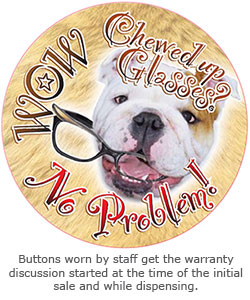By Jay Binkowitz and Evan Kestenbaum, MBA, dba Contributors
What does great customer service really mean to you and how does the culture of your business support it? Consumers want warm fuzzies when they make a decision to spend money, but a nice smile, a nice selection and great quality are simply not enough.
If you visited a fine restaurant and were unhappy with your meal, even after eating it, or unhappy with your wine, even after drinking half of it, they would say, "I am sorry you're not happy, what can I bring you instead." Their only goal is to make sure you're happy.
The best way to ease the fear of spending money in your customers' minds is to leverage your after sale service. An unconditional warranty will generate goodwill, increase transaction dollars, boost revenue and create the type of patients we love, braggers.
This becomes even more important with multiple locations as an unhappy patient at one location can easily impact all locations through their friend network and social media.
Make Your Warranty Unconditional
The "WOW" warranty creates a consistent model your staff can be proud of and avoids unnecessary confrontations. This is how the WOW warranty works: "We will repair or replace your glasses at any time for any reason for 12 months. Even if the dog eats them! No matter what happens to your glasses, we will replace them with a $25 co-payment. You only pay the co-payment if you use the warranty."
Remember, it's not your suppliers who took your patient's money. You did. So whatever their policies may be are irrelevant to the type of service you provide. Leveraging warranties can help ease the mind of your consumers and differentiate your locations from the competition. As a multi-location business you can provide even greater service by letting your patients know they can visit any location to receive this great service.
Patients can use this warranty as often as they like for 12 months from the original date of purchase. The only stipulation for patients is that the warranty provided by their vision plan supersedes your WOW warranty. The warranty also does not cover loss or theft. Also, when the patients use their warranty, they must return their old frames, even if there are only a few parts left.
Use the Term 'Co-payment'
We are not selling the warranty. It's free. Use the term "co-payment" because patients understand they are entitled to a "free" exam but have a co-payment. It's the same with their warranty. We don't want to tell them they are paying shipping or lab fees since these costs are our problem, not theirs. They only pay the co-payment when they use it. This is a great gatekeeper that establishes value while ensuring that the policy is not abused.

|
If a patient has spent a lot of money with us, or their entire family comes to us, we will let them know that we are waiving the co-payment of $25 "this time" as a special thank you to them. It is important to have the $25 value for them to understand what you are doing for them. If you just say, "No problem. We'll take care of it," they will not understand the value. We will also occasionally extend the warranty when it is appropriate. As you can see in the "Case Study" box, the warranty proves to be profitable on many levels.
We do not support 24-month warranties. Offering a patient a one-time service in 24 months, or more often in some cases, does not provide exceptional customer service, even if the labs or frame companies give you flexibility to do it. There is no benefit to us to make a new pair of glasses in 23 months and see a patient once in four years.
The most important rule of thumb with customer service initiatives is not to punish 99 percent of your patients because of the 1 percent who may take advantage of you, whether or not the companies will give you credit. Don't create rules and policies that abuse all of your patients because of a few.
Customer Service and Revenue Generator
The WOW warranty has been an incredible success as both a customer service initiative and as a revenue model. Frame warranties are more important than ever. With the onslaught of availability from purchasing eyewear online and the consistent pressure from low-end retailers, we have to carve out a value that far exceeds our patient expectations. We need to remember that once a patient walks over the threshold from our examination rooms they become consumers. We have to make sure we communicate this value by incorporating a scripted model for our staff and support materials for consumers.
Never use your lab or frame company as an excuse for not providing a liberal warranty policy. We replace frames even in the rare cases when our lab or frame vendors don't cover replacements. The co-payments we collect cover the occasional lab or frame vendor replacement fees. You can easily keep track of the co-payments collected, but the return on investment of your warranty should be measured as a customer service and marketing initiative. We need to protect the investment consumers make when we provide products and services.
Jay Binkowitz, optometric business consultant, is chief executive officer and president of
GPN, exclusive provider of The EDGE.
Evan Kestenbaum, MBA, is chief information officer of
GPN, Exclusive Provider of The EDGE. Contact Jay and Evan directly at
clientservices.gpn@gmail.com.
For more from the current edition of "dba: Doing Business in Optical’s Local Markets," (as well as archived issues),
click here.